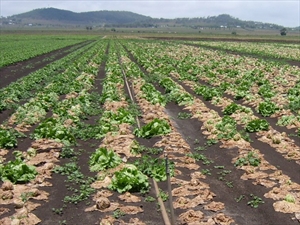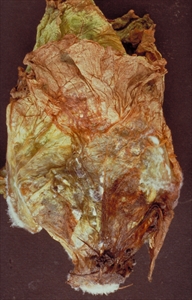Cottony soft rot, Sclerotinia soft rot, collar rot, white mould, lettuce drop.
Pacific Pests, Pathogens, Weeds & Pesticides - Online edition
Pacific Pests, Pathogens, Weeds & Pesticides
Lettuce Sclerotinia collar rot (129)
Sclerotinia sclerotiorum
Asia, Africa, North, South and Central America, the Caribbean (restricted), Europe, Oceania. It is recorded from American Samoa (tomato), Australia (bean, watercress, lettuce, potato), Cook Islands (capsicum), Fiji (bean, carrot, lettuce), New Zealand, Samoa (bean), and Tonga (bean).
Wide range of vegetables (beans, cabbage, capsicum, celery, lettuce, peanut, potato, tomato), fruit and field crops (sunflower). More than 75 plant families are hosts.
The fungus infects roots, causing rots and basal stem cankers, as well as aboveground parts causing rots to leaves, stems and fruit. It is also a cause of seedling damping-off.
Sclerotinia produces large amounts of cottony growth over rots on stems, leaves and flowers. Large, black, irregular bodies, up to 20 mm long and 7 mm wide, are formed on or in the rots; these are called 'sclerotia' (Photo 1). Sclerotia allow the fungus to survive for many years in the soil. Eventually, the sclerotia germinate in cool, moist (foggy) weather producing small (3-8 mmm diameter), cup-shaped, cream, mushroom-like bodies. These contain spores, which are forced out and carried by wind to dying leaves and flowers where they germinate, grow and infect healthy parts of the plant.
Temperatures just below 20°C are best for infection; that is why the disease is not common in the tropics, except in cool wet places.
Sclerotinia is a fungus that is more common in temperate and sub-tropical countries rather than those in the tropics. It attacks beans, cabbage, carrot, cauliflower, lettuce (Photos 2&3), lucerne, pea, peanut, potato, rapeseed, soybean (Photo 1), sunflower, tomato and more. Crop losses in the field range from negligible to 100%. Losses also occur in transit and storage. Apart from losses in yield, the disease also affects quality.
Look for the thick, white, cottony growth over leaves, stems, flowers and fruit; this could be mistaken for Pythium cottony leak (see Fact Sheet no. 128 ), so look for the characteristic black irregular-shaped sclerotia on or in the rots. Split stems open, e.g., tomato, to find the sclerotia inside.
CULTURAL CONTROL
Before planting:
- Choice of varieties: If the disease persists on beans, use staked climbing varieties rather than short bush types.
- Crop rotation: Rotate between crops that are less susceptible to Sclerotinia diseases, such as onion or sweetpotato. Note, however, that crop rotation is not very effective because of the wide host range of Sclerotinia, and because sclerotia last up to 5 years in the soil.
- Soil solarisation: Kill sclerotia (plus other pathogens and weeds) in the top 30 cm of soil by using transparent polyethylene covers. Moisten soil and cover for 4-6 weeks.
During growth:
- Soil amendment: Mulch the soil, and incorporate manures into the soil.
- Reduce crop humidity: Prevent high humidity within crops. Reduce the time that leaves are wet and susceptible to spore infection by:
- Using wider row spacing of plants.
- Using a trellis to raise foliage from the ground.
- Pruning lower branches.
After harvest:
- Ploughing: Where ploughing is practiced, turn in diseased crops immediately after harvest.
- Harvesting: Do not harvest and pack (e.g., beans, carrots, celery, potatoes and pumpkin) during wet weather, in order to prevent rots developing during transit and storage.
RESISTANT VARIETIES
Scarlet runner bean is reported to be resistant.
CHEMICAL CONTROL
For seed treatments:
Seed treatments with thiram, captan, thiophanate-methyl, iprodione and procymidone have all been used to reduce Sclerotinia wilt.
For field treatments:
It is very unlikely that soil fumigants or foliar fungicides would be used against Sclerotinia in Pacific island countries, not only because the disease is relatively rare, but also because of high costs and difficulty of obtaining pesticide products. Foliar fungicides used elsewhere include some in the bendimidazole, strobilurin, triazole and dicarboximide pesticide groups.
____________________
When using a pesticide (even a biopesticide), always wear protective clothing and follow the instructions on the product label, such as dosage, timing of application, and pre-harvest interval. Recommendations will vary with the crop and system of cultivation. Expert advice on the most appropriate pesticide to use should always be sought from local agricultural authorities.
AUTHOR Grahame Jackson
Information from (and Photo 1) Diseases of vegetable crops in Australia (2010). Editors, Denis Persley, et al.. CSIRO Publishing; and from CABI (2019) Sclerotinia sclerotiorum (cottony soft rot). Crop Protection Compendium. (https://www.cabi.org/cpc/datasheet/49124). Photos 2&3 Kohler F, et al. (1997) Diseases of cultivated crops in Pacific Island countries. South Pacific Commission. Pirie Printers Pty Limited, Canberra, Australia.
Produced with support from the Australian Centre for International Agricultural Research under project PC/2010/090: Strengthening integrated crop management research in the Pacific Islands in support of sustainable intensification of high-value crop production, implemented by the University of Queensland and the Secretariat of the Pacific Community.






